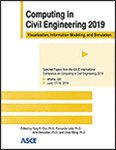ASCE International Conference on Computing in Civil Engineering 2019
Applying Deep Learning and Building Information Modeling to Indoor Positioning Based on Sound
Publication: Computing in Civil Engineering 2019: Visualization, Information Modeling, and Simulation
ABSTRACT
At present, indoor positioning has great potential for disaster mitigation, such as guiding evacuees to safe places. This research aims at developing such a sound-based method using artificial intelligence (AI) and building information modeling (BIM). Amid a disaster, first responders can quickly set up the proposed system to help indoor positioning, which relies on BIM, virtual reality (VR), and head related transfer functions (HRTF) techniques to simulate virtual sound fields. Then, a deep learning model is trained so as to be able to predict the current zone within a room based on the sound received. Unity, a serious game platform, and Steam Audio, a Unity plugin designed for adding 3D audio to VR experience, are employed to generate input data sets. The overall accuracy of the output results is about 90% though the training time is long, which can be reduced if more powerful computing resources are utilized.
Get full access to this article
View all available purchase options and get full access to this chapter.
REFERENCE
Azhar, S. (2011). “Building Information Modeling (BIM): Trends, Benefits, Risks, and Challenges for the AEC Industry.” Leadership and Management in Engineering, 11(3), 241-252.
Begault, D. R., & Trejo, L. J. (2000). 3-D sound for virtual reality and multimedia. NASA Ames Research Center, Sunnyvale, CA, USA.
Cheng, C. F., Rashidi, A., Davenport, M. A., & Anderson, D. V. (2017). “Activity analysis of construction equipment using audio signals and support vector machines.”Automation in Construction, 81, 240-253.
Dunston, P. S., Arns, L. L., Mcglothlin, J. D., Lasker, G. C., & Kushner, A. G. (2011). “An Immersive Virtual Reality Mock-Up for Design Review of Hospital Patient Rooms.” Collaborative design in virtual environments, 48, 167-176.
Eastman, C., Teicholz, P., Sacks, R., & Liston, K. (2011). BIM handbook: A Guide to Building Information Modeling for Owners, Managers, Architects, Engineers, Contractors, and Fabricators, 2nd ed. John Wiley and Sons, Hoboken, NJ, USA.
Filonenko, V., Cullen, C., & Carswell, J. (2010). “Investigating Ultrasonic Positioning on Mobile Phones.” International Conference On Indoor Positioning and Indoor Navigation, IEEE, Zurich, Switzerland.
Ibrahim, R., & Rahimian, F. P. (2010). “Comparison of CAD and manual sketching tools for teaching architectural design.” Automation in Construction, 19(8), 978-987.
Nakkiran, P., Alvarez, R., Prabhavalkar, R., & Parada, C. (2015). “Compressing Deep Neural Networks using a Rank-Constrained Topology.” Sixteenth Annual Conference of the International Speech Communication Association, ISCA, Dresden, Germany, 1473-1477.
Paes, D., Arantes, E., & Irizarry, J. (2017). “Immersive environment for improving the understanding of architectural 3D models: Comparing user spatial perception between immersive and traditional virtual reality systems.” Automation in Construction, 84, 292-303.
Pei, L., Chen, L., Guinness, R., Liu, J., Kuusniemi, H., & Chen, Y. et al. (2013). “Sound positioning using a small-scale linear microphone array.” International Conference on Indoor Positioning and Indoor Navigation, IEEE, Montbeliard-Belfort, France.
Sabillon, C. A., Rashidi, A., Samanta, B., Cheng, C. F., Davenport, M. A., & Anderson, D. V. (2018). “A Productivity Forecasting System for Construction Cyclic Operations Using Audio Signals and a Bayesian Approach.”Construction Research Congress, 295-304.
Savioja, L., & Svensson, U. P. (2015). “Overview of geometrical room acoustic modeling techniques.” The Journal of the Acoustical Society of America, 138(2), 708-730.
Vorländer, M., Schröder, D., Pelzer, S., & Wefers, F. (2015). “Virtual reality for architectural acoustics.” Journal of Building Performance Simulation, 8(1), 15-25.
Zotkin, D. N., Duraiswami, R., & Davis, L. S. (2004). “Rendering Localized Spatial Audio in a Virtual Auditory Space.” IEEE Transactions on Multimedia, 6(4), 553-564.
Information & Authors
Information
Published In
Computing in Civil Engineering 2019: Visualization, Information Modeling, and Simulation
Pages: 193 - 199
Editors: Yong K. Cho, Ph.D., Georgia Institute of Technology, Fernanda Leite, Ph.D., University of Texas at Austin, Amir Behzadan, Ph.D., Texas A&M University, and Chao Wang, Ph.D., Louisiana State University
ISBN (Online): 978-0-7844-8242-1
Copyright
© 2019 American Society of Civil Engineers.
History
Published online: Jun 13, 2019
Authors
Metrics & Citations
Metrics
Citations
Download citation
If you have the appropriate software installed, you can download article citation data to the citation manager of your choice. Simply select your manager software from the list below and click Download.
